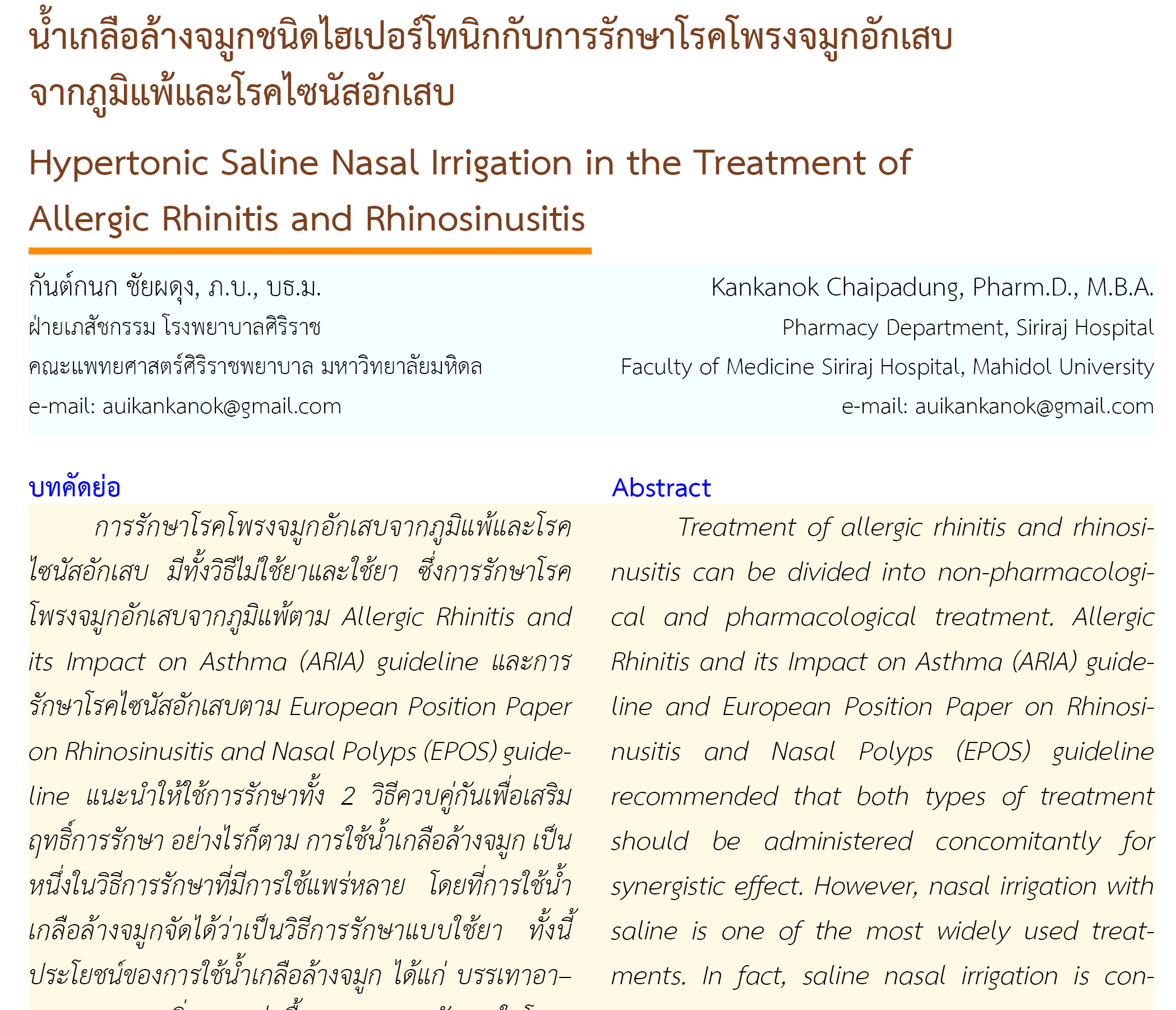น้ำเกลือล้างจมูกชนิดไฮเปอร์โทนิกกับการรักษาโรคโพรงจมูกอักเสบจากภูมิแพ้และโรคไซนัสอักเสบ
คำสำคัญ:
โรคโพรงจมูกอักเสบจากภูมิแพ้, โรคไซนัสอักเสบ, น้ำเกลือล้างจมูกชนิดไฮเปอร์โทนิก, น้ำเกลือ, ล้างจมูกบทคัดย่อ
การรักษาโรคโพรงจมูกอักเสบจากภูมิแพ้และโรคไซนัสอักเสบ มีทั้งวิธีไม่ใช้ยาและใช้ยา ซึ่งการรักษาโรคโพรงจมูกอักเสบจากภูมิแพ้ตาม Allergic Rhinitis and its Impact on Asthma (ARIA) guideline และการรักษาโรคไซนัสอักเสบตาม European Position Paper on Rhinosinusitis and Nasal Polyps (EPOS) guideline แนะนำให้ใช้การรักษาทั้ง 2 วิธีควบคู่กันเพื่อเสริมฤทธิ์การรักษา อย่างไรก็ตาม การใช้น้ำเกลือล้างจมูก เป็นหนึ่งในวิธีการรักษาที่มีการใช้แพร่หลาย โดยที่การใช้น้ำเกลือล้างจมูกจัดได้ว่าเป็นวิธีการรักษาแบบใช้ยา ทั้งนี้ประโยชน์ของการใช้น้ำเกลือล้างจมูก ได้แก่ บรรเทาอาการทางจมูก เพิ่มความชุ่มชื้น และลดการอักเสบในโพรงจมูก ในปัจจุบันมีงานวิจัยที่ศึกษาประสิทธิภาพความเข้มข้นของน้ำเกลือที่ใช้ล้างจมูกทั้งชนิดไอโซโทนิก (น้ำเกลือความเข้มข้นร้อยละ 0.9) และชนิดไฮเปอร์โทนิก (น้ำเกลือความเข้มข้นมากกว่าร้อยละ 0.9) ทั้งในผู้ป่วยเด็กและผู้ใหญ่ พบว่า การใช้น้ำเกลือล้างจมูกชนิดไฮเปอร์โทนิก มีประสิทธิภาพในการรักษาอาการทางจมูกทั้งการลดน้ำมูกและอาการคัดแน่นจมูกได้ดีกว่าการใช้น้ำเกลือล้างจมูกชนิดไอโซโทนิกอย่างมีนัยสำคัญทางสถิติ โดยพบว่า น้ำเกลือล้างจมูกชนิดไฮเปอร์โทนิกเพิ่มประสิทธิภาพการทำงานของซิเลีย ทำให้ซิเลียพัดโบกได้ดีขึ้น และป้องกันไม่ให้มีการคั่งของน้ำมูกในโพรงไซนัส นอกจากนี้ น้ำเกลือล้างจมูกชนิดไฮเปอร์โทนิก ยังมีแรงดันออสโมติกสูงกว่าน้ำเกลือล้างจมูกชนิดไอโซโทนิก ทำให้เพิ่มประสิทธิภาพการลดอาการบวมในโพรงจมูก จึงสามารถดึงน้ำออกจากเนื้อเยื่อบริเวณที่บวมในโพรงจมูกได้มากขึ้น อาการไม่พึงประสงค์ที่พบได้บ่อย ได้แก่ การระคายเคือง แสบร้อนในโพรงจมูก และเลือดกำเดาไหล สรุปได้ว่า ควรพิจารณาใช้น้ำเกลือล้างจมูกชนิดไฮเปอร์โทนิก เฉพาะเมื่อต้องการเพิ่มประสิทธิภาพในการรักษาและเพิ่มคุณภาพชีวิตให้แก่ผู้ป่วย
เอกสารอ้างอิง
Hwang C, Desai B, Desai A. Sinonasal diseases. In: Desai B, Desai A, editors. Primary care for emergency physicians.1st ed. Cham, Switzerland: Springer International Publishing; 2017:p.69-77.
Sheikh J, Jean T. What is the global prevalence of allergic rhinitis (hay fever)?. [Internet]. 2018 [cited 2021 Feb 9]. Available from: https://www.medscape.com/answers/134825-4371/what-is-the-global-prevalence-of-allergic-rhinitis-hay-fever
Fokkens WJ, Lund VJ, Hopkins C, Hellings PW, Kern R, Reitsma S, et al. European position paper on rhinosinusitis and nasal polyps 2020. Rhinology. 2020;58(Suppl S29):1-464.
Principi N, Esposito S. Nasal irrigation: An imprecisely defined medical procedure. Int J Environ Res Public Health. 2017;14(5):1-13.
สมาคมโรคระบบหายใจและเวชบำบัดวิกฤตในเด็ก ราชวิทยาลัยกุมารแพทย์แห่งประเทศไทย. แนวทางการดูแลรักษาโรคติดเชื้อเฉียบพลันระบบหายใจในเด็ก พ.ศ. 2562. พิมพ์ครั้งที่ 1. นนทบุรี: บียอนด์เอ็นเทอร์ไพรซ์; 2562.
Okubo K, Kurono Y, Ichimura K, Enomoto T, Okamoto Y, Kawauchi H, et al. Japanese guidelines for allergic rhinitis 2020. Allergol Int. 2020;69(3):331-45.
Dykewicz MS, Wallace DV, Amrol DJ, Baroody FM, Bernstein JA, Craig TJ, et al. Rhinitis 2020: A practice parameter update. J Allergy Clin Immunol. 2020;146(4):721-67.
Bousquet J, Khaltaev N, Cruz AA, Denburg J, Fokkens WJ, Togias A, et al. Allergic rhinitis and its impact on asthma (ARIA) 2008 update (in collaboration with the World Health Organization, GA(2)LEN and AllerGen). Allergy. 2008; 63(Suppl.86): 8–160.
Head K, Snidvongs K, Glew S, Scadding G, Schilder AG, Philpott C, et al. Saline irrigation for allergic rhinitis. Cochrane Database Syst Rev. 2018;6(6):CD012597-CD.
Slapak I, Skoupá J, Strnad P, Horník P. Efficacy of isotonic nasal wash (seawater) in the treatment and prevention of rhinitis in children. Arch Otolaryngol Head Neck Surg. 2008;134(1):67-74.
Aring AM, Chan MM. Acute rhinosinusitis in adults. Am Fam Physician. 2011;83(9):1057-63.
ปารยะ อาศนะเสน. ไซนัสอักเสบ สำคัญหรือไม่ในการดูแลผู้ป่วยโรคหืด. คลินิก. 2559;32(8):802-935.
Bennett WD, Wu J, Fuller F, Balcazaret JR, Zeman KL, Duckworth H, et al. Duration of action of hypertonic saline on mucociliary clearance in the normal lung. J Appl Physiol. 2015;118:1483–90.
Wang YH, Yang CP, Ku MS, Sun HL, Lue KH. Efficacy of nasal irrigation in the treatment of acute sinusitis in children. Int J Pediatr Otorhinolaryngol. 2009;73(12):1696-701.
Bergmann C, Müller K, Thieme U, Zeman F, Huppertz G, Koller M, et al. Real-world data on the use of hypertonic saline nasal spray in ENT practice. SN Compr Clin Med. 2019;1(5):354-61.
Talbot AR, Herr TM, Parsons DS. Mucociliary clearance and buffered hypertonic saline solution. Laryngoscope. 1997;107(4):500-3.
Keojampa BK, Nguyen MH, Ryan MW. Effects of buffered saline solution on nasal mucociliary clearance and nasal airway patency. Otolaryngol Head Neck Surg. 2004;131(5):679-82.
Wang Y, Jin L, Liu S, Fan K, Qin M-L, Yu S-Q. Role of nasal saline irrigation in the treatment of allergic rhinitis in children and adults: A systematic analysis. Allergol Immunopathol. 2020;48(4):360-67.
Marchisio P, Varricchio A, Baggi E, Bianchini S, Capasso ME, Torretta S, et al. Hypertonic saline is more effective than normal saline in seasonal allergic rhinitis in children. Int J Immunopathol Pharmacol. 2012;25(3):721-30.
Sansila K, Eiamprapai P, Sawangjit R. Effects of self-prepared hypertonic nasal saline irrigation in allergic rhinitis: A randomized controlled trial. Asian Pac J Allergy Immunol. 2020;38(3):200-7.
Li CL, Lin HC, Lin CY, Hsu TF. Effectiveness of hypertonic saline nasal irrigation for alleviating allergic rhinitis in children: A systematic review and meta-analysis. J Clin Med. 2019;8(1):1-10.
Liu L, Pan M, Li Y, Tan G, Yang Y. Efficacy of nasal irrigation with hypertonic saline on chronic rhinosinusitis: Systematic review and meta-analysis. Braz J Otorhinolaryngol. 2020;86(5):639-46.
Berjis N, Sonbolastan SM, Okhovat SH, Narimani AA, Razmjui J. Normal saline versus hypertonic 3% saline: It’s efficacy in non-acute rhinosinusitis. Iran J Otorhinolaryngol. 2011;23(1):23-8.
กิตติยาพร แสนศิลา, ภีม เอี่ยมประไพ, ราตรี สว่างจิตร. คุณสมบัติของน้ำเกลือสวนล้างจมูกแบบเตรียมเอง. วารสารเภสัชกรรมไทย. 2561;10(1):69-81.

ดาวน์โหลด
เผยแพร่แล้ว
รูปแบบการอ้างอิง
ฉบับ
ประเภทบทความ
สัญญาอนุญาต
ข้อความภายในบทความที่ตีพิมพ์ในวารสารเภสัชกรรมโรงพยาบาลทั้งหมด รวมถึงรูปภาพประกอบ ตาราง เป็นลิขสิทธิ์ของสมาคมเภสัชกรรมโรงพยาบาล (ประเทศไทย) การนำเนื้อหา ข้อความหรือข้อคิดเห็น รูปภาพ ตาราง ของบทความไปจัดพิมพ์เผยแพร่ในรูปแบบต่าง ๆ เพื่อใช้ประโยชน์ในเชิงพาณิชย์ ต้องได้รับอนุญาตจากกองบรรณาธิการวารสาร (สมาคมเภสัชกรรมโรงพยาบาล (ประเทศไทย)) อย่างเป็นลายลักษณ์อักษร
สมาคมเภสัชกรรมโรงพยาบาล (ประเทศไทย) อนุญาตให้สามารถนำไฟล์บทความไปใช้ประโยชน์และเผยแพร่ต่อได้ โดยอยู่ภายใต้เงื่อนไขสัญญาอนุญาตครีเอทีฟคอมมอน (Creative Commons License: CC) โดย ต้องแสดงที่มาจากวารสาร – ไม่ใช้เพื่อการค้า – ห้ามแก้ไขดัดแปลง, Attribution-NonCommercial-NoDerivatives 4.0 International (CC BY-NC-ND 4.0)
ข้อความที่ปรากฏในบทความในวารสารเป็นความคิดเห็นส่วนตัวของผู้เขียนแต่ละท่านไม่เกี่ยวข้องกับสมาคมเภสัชกรรมโรงพยาบาล (ประเทศไทย) และบุคลากรในสมาคมฯ แต่อย่างใด ความรับผิดชอบองค์ประกอบทั้งหมดของบทความแต่ละเรื่องเป็นของผู้เขียนแต่ละท่าน หากมีความผิดพลาดใด ๆ ผู้เขียนแต่ละท่านจะรับผิดชอบบทความของตนเอง ตลอดจนความรับผิดชอบด้านเนื้อหาและการตรวจร่างบทความเป็นของผู้เขียน ไม่เกี่ยวข้องกับกองบรรณาธิการ


.png)

